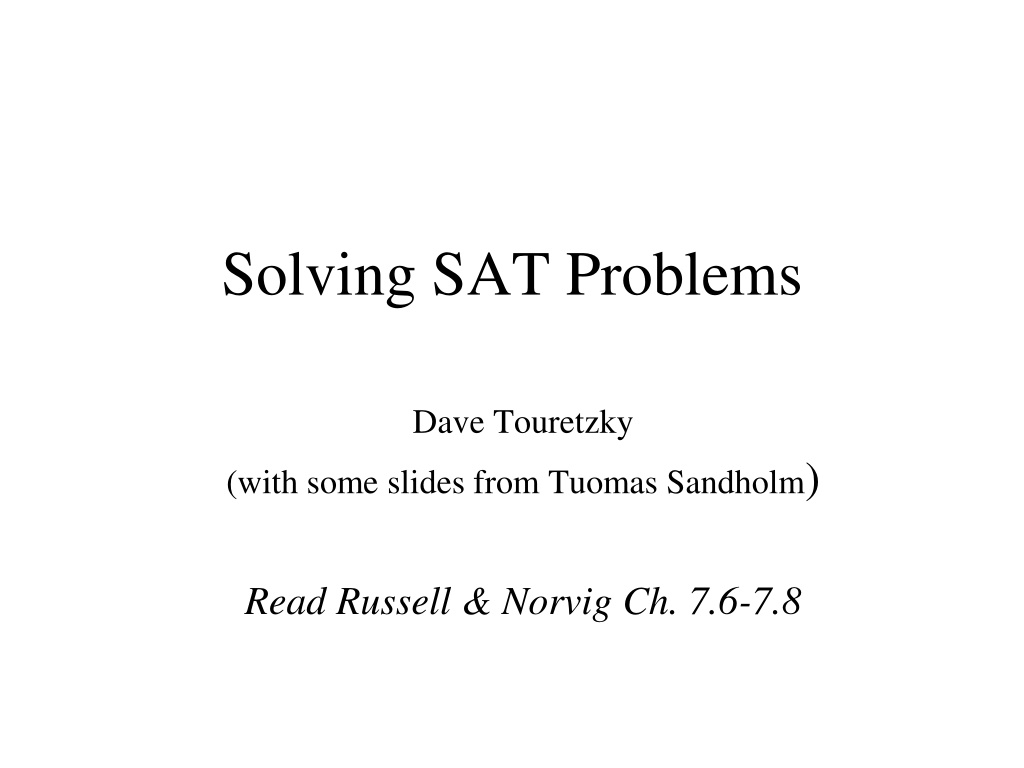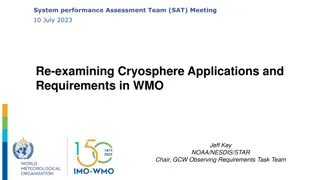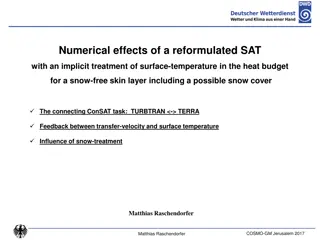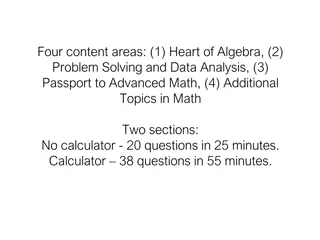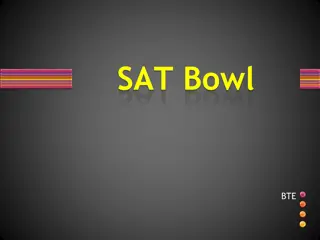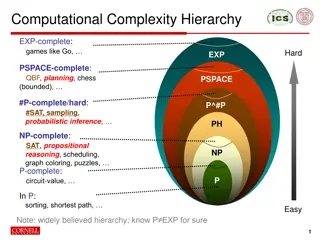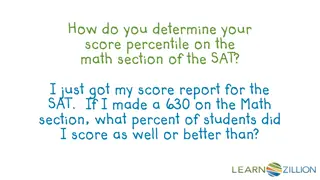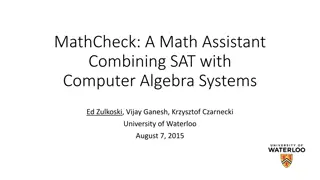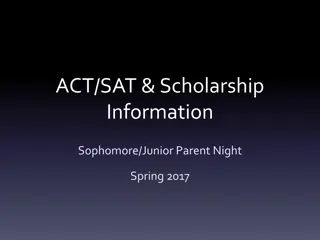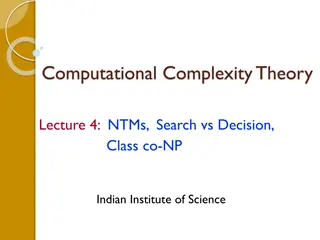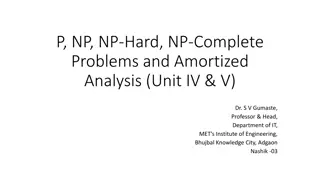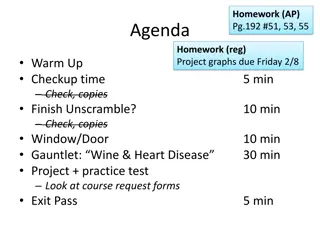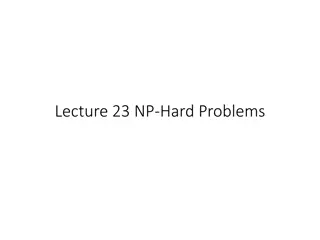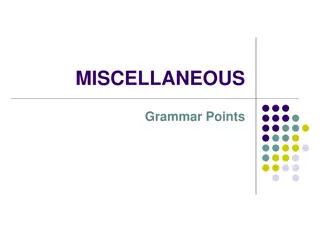Understanding SAT Problems and Solution Techniques
Exploring SAT problems and solution techniques such as truth table enumeration, theorem proving, and specialized algorithms for definite clauses. Dive into forward chaining algorithms and their role in solving satisfiability problems efficiently.
Download Presentation

Please find below an Image/Link to download the presentation.
The content on the website is provided AS IS for your information and personal use only. It may not be sold, licensed, or shared on other websites without obtaining consent from the author. Download presentation by click this link. If you encounter any issues during the download, it is possible that the publisher has removed the file from their server.
E N D
Presentation Transcript
Solving SAT Problems Dave Touretzky (with some slides from Tuomas Sandholm) Read Russell & Norvig Ch. 7.6-7.8
Overview Satisfiability problems are CSPs with boolean variables. Solution techniques: 1. Truth table enumeration. 2. Theorem proving: 3. Today: Sophisticated model checking algorithms. 2
1. Truth Table Enumeration A simple form of model checking. A formula s is satisfiable if it has at least one model. [(p q) (q p)] r P Q R false false false false false true Possible Models false true false false true true true false false true false true true true false true true true 3
2. Theorem Proving Manipulate the constraints (formulae) by deriving new constraints. Use the resolution inference rule. Requires conjunctive normal form (CNF). Works great for definite clauses: One positive literal per clause. Inference is purely modus ponens. Can bog down if formulae are more complex. 4
Special Case: Definite Clauses Definite clause: exactly one positive literal. Horn clause: at most one positive literal. Specialized algorithms exist for proving propositions from facts + definite clauses. Forward chaining and backward chaining The algorithms don t explicitly do resolution, but they are consistent with the resolution rule. 5
Forward Chaining Algorithm function PLC-FC-ENTAILS?(KB,q) returns true or false inputs: KB, the knowledge base, a set of propositional definite clauses q, the query, a propositional symbol count a table, where count[c] is initially the # of symbols in c s premise inferred a table, where inferred[s] is initially false for all symbols agenda a queue of symbols, initially symbols known to be true in KB while agenda is not empty do p POP(agenda) if p = q then return true if inferred[p] = false then inferred[p] true for each clause c in KB where p is in c.PREMISE do decrement count[c] if count[c] = 0 then add c.CONCLUSION to agenda return false 6
Forward Chaining: And/Or Graph P Q L M P B L M A P L A B L A B Implications as definite clauses Facts (initial agenda) 7
Backward Chaining Algorithm Start with the goal proposition. For all implications s that affirm the goal: For all the premises p of s: If p is given, continue. If p is above us on the goal stack: next s. Otherwise, recursively try to prove p; if failure, return false. Return true. Return false. 8
Backward Chaining: And/Or Graph P Q L M P B L M A P L A B L A B Implications as definite clauses Facts 9
3. Sophisticated Model Checking Use CSP heuristic techniques to search the space of variable assignments. We ll consider two approaches: Backtracking search: DPLL algorithm Local search: WALK-SAT, GSAT, BREAKOUT 10
Davis-Putnam-Logemann-Loveland (DPLL) Algorithm Input is a sentence in CNF Depth-first, backtracking enumeration of possible models, with three tricks: 1) Early termination 2) Pure symbol heuristic 3) Unit clause heuristic 11
Early Termination A clause is true if any of its literals is true. Can work with partial models; don t have to wait for the remaining variables to be assigned. A sentence is false if any clause is false. Can avoid examination of entire subtrees in the search space. 12
Pure Symbol Heuristic A pure symbol has the same sign in all clauses. Ex: A and B are pure (and C is not) in: (A B), ( B C), (C A) If a sentence has a model, then it has a model in which the pure symbols are assigned values that make their literals true. Why? Because there are no opposite sign literals that could make any clause be false. 13
Symbols Can Become Pure Symbols can become pure if some other literal is assigned a value that makes a clause true. In that case, the symbol s appearance in that clause can be ignored. 14
Unit Clause Heuristic In DPLL, a unit clause is a clause in which all literals but one are already assigned false by the model. Example: ( B C) when B = true. This simplifies to C, a unit clause. So C must be false. Now (C A) becomes a unit clause. This is called unit propagation. 15
function DPLL-SATISFIABLE?(s) returns true or false inputs: s, a sentence in propositional logic clauses the set of clauses in the CNF representation of s symbols a list of the proposition symbols in s return DPLL(clauses, symbols, {}) function DPLL(clauses, symbols, model) returns true or false if every clause in clauses is true in model then return true if some clause in clauses is false in model then return false P, value FIND-PURE-SYMBOL(clauses, model) if P is non-null then return DPLL(clauses, symbols - P, model {P=value}) P, value FIND-UNIT-CLAUSE(clauses, model) if P is non-null then return DPLL(clauses, symbols - P, model {P=value}) P FIRST(symbols); rest REST(symbols) return DPLL(clauses, rest, model {P=true}) or DPLL(clauses, rest, model {P=false}) This is where the backtracking happens. 16
Davis-Putnam-Logemann-Loveland (DPLL) tree search algorithm clause E.g. for 3SAT ? s.t. (p1 p3 p4) ( p1 p2 p3) p1 T F p2 T F p3 Complete p4 Backtrack when some clause becomes empty Unit propagation (for variable & value ordering): if some clause only has one literal left, assign that variable the value that satisfies the clause (never need to check the other branch) Boolean Constraint Propagation (BCP): Iteratively apply unit propagation until there is no unit clause available 17
A helpful observation for the DPLL procedure P1 P2 Pn Q is equivalent to (P1 P2 Pn) Q is equivalent to P1 P2 Pn Q (Horn) (Horn) (Horn clause) Thrm. If a propositional theory consists only of Horn clauses (i.e., clauses that have at most one non-negated variable) and unit propagation does not result in an explicit contradiction (i.e., Pi and Pi for some Pi), then the theory is satisfiable. Proof. On the next page. so, Davis-Putnam algorithm does not need to branch on variables which only occur in Horn clauses 18
Proof of the theorem Assume the theory is Horn, and that unit propagation has completed (without contradiction). We can remove all the clauses that were satisfied by the assignments that unit propagation made. From the unsatisfied clauses, we remove the variables that were assigned values by unit propagation. The remaining theory has the following two types of clauses that contain unassigned variables only: P1 P2 Pn Q and P1 P2 Pn Each remaining clause has at least two variables (otherwise unit propagation would have applied to the clause). Therefore, each remaining clause has at least one negated variable. Therefore, we can satisfy all remaining clauses by assigning each remaining variable to False. 19
Variable ordering heuristic for DPLL [Crawford & Auton AAAI-93] Heuristic: Pick a non-negated variable that occurs in a non- Horn (more than 1 non-negated variable) clause with a minimal number of non-negated variables. Motivation: This is effectively a most constrained first heuristic if we view each non-Horn clause as a variable that has to be satisfied by setting one of its non-negated variables to True. In that view, the branching factor is the number of non-negated variables the clause contains. 20
Variable ordering heuristic for DPLL Q: Why is branching constrained to non-negated variables? A: We can ignore any negated variables in the non-Horn clauses because whenever any one of the non-negated variables is set to True the clause becomes redundant (satisfied), and whenever all but one of the non-negated variables is set to False the clause becomes Horn. Variable ordering heuristics can make several orders of magnitude difference in speed. 21
Beyond DPLL State of the art SAT solvers can handle expressions with tens of millions of variables. Used in applications such as VLSI chip verification. How do they do it? More heuristics! 22
SAT Solver Heuristics 1. Component analysis: variables that appear in disjoint sets of clauses can be separated and the subproblems solved independently. 2. Variable and value ordering. The degree heuristic suggests choosing the variable that appears most frequently over all remaining clauses. 23
SAT Solver Heuristics 3. Intelligent backtracking: jump back far enough to reach a variable responsible for the failure. Conflict clause learning can record conflicts so they won t be repeated later. 4. Random restarts if a run appears not to be making progress allow different choices of variables and values. Learned conflict clauses are retained. 24
SAT Solver Heuristics 5. Clever indexing provides fast access to things such as the set of clauses in which the variable Xiappears as a positive literal. Must be computed dynamically because we only care about clauses that have not yet been satisfied. 25
Clause learning (aka nogood learning) (used by state-of-the-art SAT solvers) Dotted arrows not explored yet Conflict graph: x2=0 x2=0 Which cut(s) should we use? Any cut that separates the conflict from the yellow reason nodes would give a valid clause. Clause from first-unique-implication-point (1UIP) cut is shown here. 1UIP scheme performs well in practice. The learned clauses apply to all other parts of the tree. Should we delete some clauses at some point? 27
Conflict-directed backjumping (A step-by-step walk-through of this example is also at https://en.wikipedia.org/wiki/Conflict-Driven_Clause_Learning) Dotted arrows not explored yet x7=0 Failure-driven assertion (not a branching decision): Learned clause is a unit clause under this path, so BCP automatically sets x7=0. x2=0 x2=0 Then backjump to the decision level of x3=1, keeping x3=1 (for now), and forcing the implied fact x7=0 for that x3=1 branch WHAT S THE POINT? A: No need to just backtrack to x2 28
Classic readings on conflict-directed backjumping, clause learning, and heuristics for SAT GRASP: A Search Algorithm for Propositional Satisfiability , Marques-Silva & Sakallah, IEEE Trans. Computers, C-48, 5:506-521,1999. (Conference version 1996.) ( Using CSP look-back techniques to solve real world SAT instances , Bayardo & Schrag, Proc. AAAI, pp. 203-208, 1997) Chaff: Engineering an Efficient SAT Solver , Moskewicz, Madigan, Zhao, Zhang & Malik, 2001 (www.princeton.edu/~chaff/publication/DAC2001v56.pdf) BerkMin: A Fast and Robust Sat-Solver , Goldberg & Novikov, Proc. DATE 2002, pp. 142-149 See also slides at http://www.princeton.edu/~sharad/CMUSATSeminar.pdf 29
Generalizing backjumping from SAT to CSPs 30
Basic backjumping in CSPs Conflict set of a variable: all previously assigned variables connected to that variable by at least one constraint When the search reaches a variable V with no legal values remaining, backjump to the most recently assigned variable in V s conflict set Conflict set is updated while trying to find a legal value for the variable Vertex C has no legal values left! The search backjumps to the most recent vertex in its conflict set: Un-assigns value to B, un-assigns value to A Retries a new value at A If no values left at A, backjump to most recent node in A s conflict set, etc. Values(A) = {R,B} Values(B) = {R,B} Values(B) = {B} A B C Conflicts(C) = {} Conflicts(C) = {A=R} Values(C) = {R} Values(C) = {} Every branch pruned by basic backjumping is also pruned by forward checking 31
Conflict-directed backjumping in CSPs Basic backjumping isn t very powerful: Consider the partial assignment {WA=red, NSW=red} Suppose we set T=red next Then we assign NT, Q, V, SA We know no assignment can work for these, so eventually we run out of values for NT Where to backjump? Basic backjumping wouldn t work, i.e., we d just backtrack to T (because NT doesn t have a complete conflict set with the preceding assignments: it does have values available) But we know that NT, Q, V, SA, taken together, failed because of a set of preceding variables, which must be those variables that directly conflict with the four => Deeper notion of conflict set: it is the set of preceding variables (WA and NSW) that caused NT, together with any subsequent variables, to have no consistent solution We should backjump to NSW and skip over T. Conflict-directed backjumping (CBJ): Let Xjbe the current variable, and conf(Xj) its conflict set. We exhaust all values for Xj. Backjump to the most recently assigned variable in conf(Xj), denoted Xi. Set conf(Xi) = conf(Xi) conf(Xj) {Xi} If we need to backjump from Xi , repeat this process. WA NSW T NT Q V SA Study this example step by step from Russell & Norvig Chapter 6. 32
Nogood learning in CSPs Conflict-directed backjumping computes a set of variables and values that, when assigned in unison, creates a conflict It is usually the case that only a subset of this conflict set is sufficient for causing infeasibility Idea: Find a small set of variables from the conflict set that causes infeasibility We can forbid this combination by adding a new constraint to the problem or putting it in a dynamic nogood pool Useful for guiding future search paths away from similar problem (i.e., guaranteed infeasible) areas of the search space Conflict sets are either local or global: Global: If this subset of variables have these certain values, the problem is always infeasible Local: Constraint is only valid for a certain subset of search space 33
Advanced topic: More on conflict-directed backjumping (CBJ) and nogood learning These are for general CSPs, not SAT specifically: Conflict-directed backjumping revisited by Chen and van Beek, Journal of AI Research, 14, 53-81, 2001: As the level of local consistency checking (lookahead) is increased, CBJ becomes less helpful A dynamic variable ordering exists that makes CBJ redundant Nevertheless, adding CBJ to backtracking search that maintains generalized arc consistency leads to orders of magnitude speed improvement experimentally Generalized NoGoods in CSPs by Katsirelos & Bacchus, National Conference on Artificial Intelligence (AAAI-2005) pages 390-396, 2005 Generalized nogoods so that they can express nogoods to contain either assignments or non-assignments Then nogood learning can speed up (even non-SAT) CSPs significantly An optimal coarse-grained arc consistency algorithm by Bessiere et al. Artificial Intelligence, 2005 Fastest CSP solver at the time; uses generalized arc consistence and no CBJ 34
Random restarts Sometimes it makes sense to keep restarting the CSP/SAT algorithm, using randomization in variable ordering [see, e.g., work by Carla Gomes et al.] Avoids the very long run times of unlucky variable ordering On many problems, yields faster algorithms Heavy-tailed runtime distribution is a sufficient condition for this All good complete SAT solvers use random restarts nowadays Clauses learned can be carried over across restarts Experiments suggest it does not help on optimization problems (e.g., [Sandholm et al. IJCAI-01, Management Science 2006]) When to restart? If there were a known runtime distribution, there would be one optimal restart time (i.e., time between restarts). Denote by R the resulting expected total runtime In practice the distribution is not known. Luby-Sinclair-Zuckerman [1993] restart scheme (1,1,2,1,1,2,4, 1,1,2,1,1,2,4,8, ) achieves expected runtime R(192 log(R) + 5) Useful, and used, in practice The theorem was derived for independent runs, but here the nogood database (and the upper and lower bounds on the objective in case of optimization) can be carried over from one run to the next 36
Order parameter for 3SAT [Mitchell, Selman, Levesque AAAI-92] = #clauses / # variables This predicts satisfiability hardness of finding a model 38
Generality of the order parameter The results seem quite general across model finding algorithms Other constraint satisfaction problems have order parameters as well 41
but the complexity peak does not occur (at least not in the same place) under all ways of generating SAT instances 42
Iterative refinement (local search) algorithms for SAT
WALKSAT function WALKSAT(clauses, p, max_flips) returns a model or failure inputs: clauses, a set of clauses in propositional logic p, the probability of choosing to do a random walk, typically around 0.5 max_flips, number of flips allowed before giving up model a random assignment of true/false to the symbols in clauses for i = 1 to max_flips do if model satisfies clauses then return model clause a randomly selected clause from clauses that is false in model with probability p flip the value in model of a randomly selected symbol from clause else flip whichever symbol in clause maximizes the # of satisfied clauses return failure 44
GSAT [Selman, Levesque, Mitchell AAAI-92] (= a local search algorithm for model finding) Incomplete (unless restart a lot) Avg. total flips 50 variables, 215 3SAT clauses 2000 1600 1200 800 400 Greediness is not essential as long as climbs and sideways moves are preferred over downward moves. max-climbs 45 100 200
BREAKOUT algorithm [Morris AAAI-93] Initialize all variables Pirandomly UNTIL current state is a solution IF current state is not a local minimum THEN make any local change that reduces the total cost (i.e., flip one Pi) ELSE increase weights of all unsatisfied clauses by one Incomplete, but very efficient on large (easy) satisfiable problems. Reason for incompleteness: the cost increase of the current local optimum spills over to other solutions because they share unsatisfied clauses. 46
Summary of the algorithms we covered for inference in propositional logic Truth table method Inference rules, e.g., resolution Model finding algorithms Davis-Putnam (Systematic backtracking) Early backtracking when a clause is empty Unit propagation Variable (& value?) ordering heuristics Local search WALKSAT GSAT BREAKOUT 47
